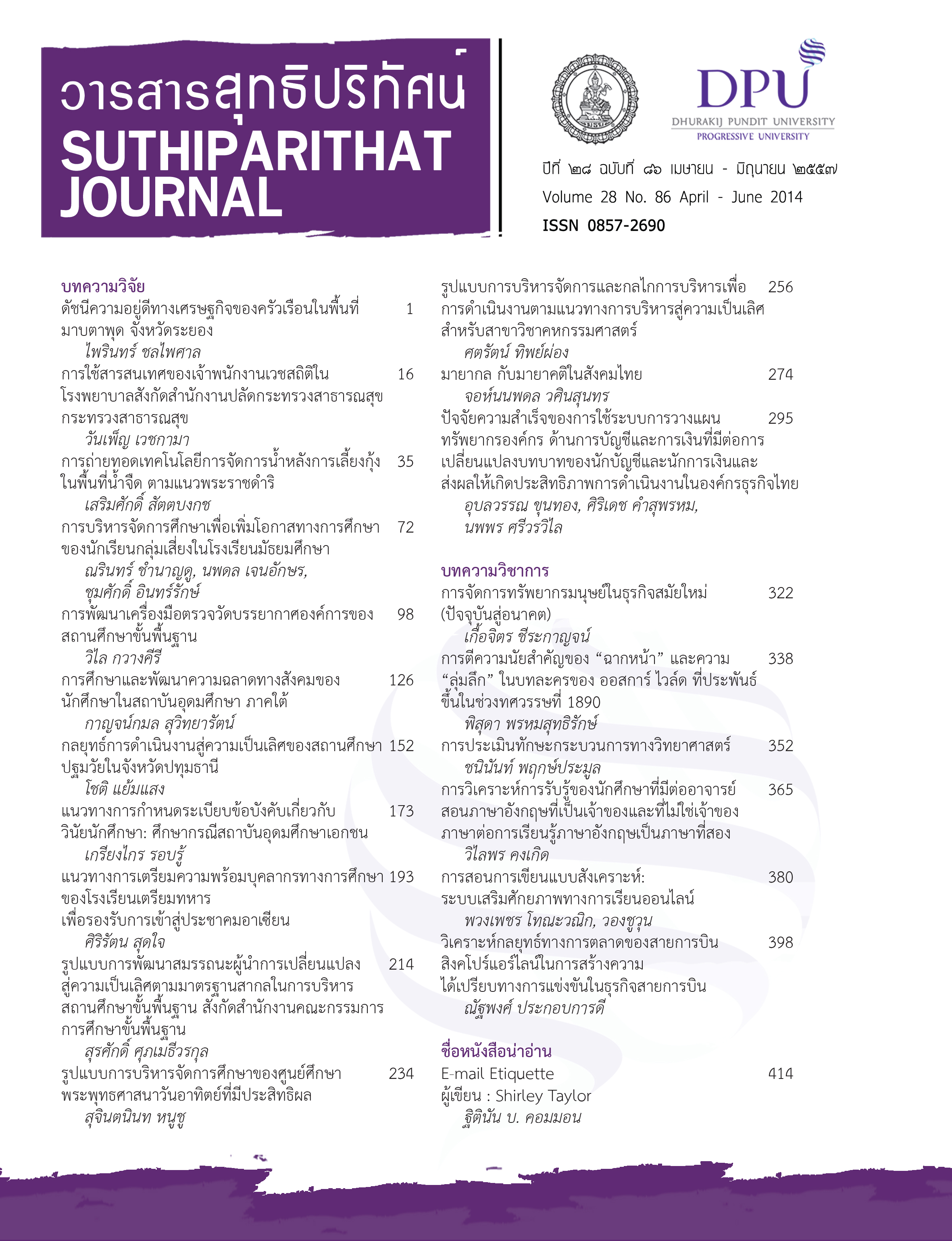การพัฒนาเครื่องมือตรวจวัดบรรยากาศองค์การของสถานศึกษาขั้นพื้นฐาน
คำสำคัญ:
บรรยากาศองค์การ, สถานศึกษาขั้นพื้นฐานบทคัดย่อ
การวิจัยนี้มีวัตถุประสงค์เพื่อทราบองค์ประกอบบรรยากาศองค์การของสถานศึกษาขั้นพื้นฐานความสัมพันธ์ขององค์ประกอบบรรยากาศองค์การของสถานศึกษาขั้นพื้นฐาน และผลการพัฒนาเครื่องมือตรวจวัดบรรยากาศองค์การของสถานศึกษาขั้นพื้นฐาน การวิจัยแบ่งเป็น 3 ขั้นตอน คือ 1) ศึกษาค้นคว้าตัวแปรเกี่ยวกับบรรยากาศองค์การของสถานศึกษาขั้นพื้นฐาน 2) การพัฒนาเครื่องมือและจัดเก็บข้อมูล และ 3) การวิเคราะห์ข้อมูลกลุ่มตัวอย่างสถานศึกษาขั้นพื้นฐาน 200 โรงเรียน ตัวอย่างที่ให้ข้อมูลแบ่งเป็น 3 กลุ่มคือ ผู้บริหารสถานศึกษา หัวหน้างานวิชาการและครู เครื่องมือที่ใช้ในการเก็บข้อมูลเป็น แบบสอบถามแบบ rubric scale ที่เกี่ยวกับบรรยากาศองค์การของสถานศึกษาขั้นพื้นฐาน เก็บข้อมูลระหว่างวันที่ 15 มกราคม – 16 พฤษภาคม 2556 สถิติที่ใช้ในการวิเคราะห์ข้อมูลได้แก่ การหาค่าความถี่ (frequency) ค่าร้อยละ (percentage) ค่ามัชฌิมเลขคณิต (arithmetic mean) ค่าเบี่ยงเบนมาตรฐาน (standard deviation) การวิเคราะห์องค์ประกอบเชิงสำรวจ (exploratory factor analysis) การทดสอบค่าที (t-test) การวิเคราะห์ความสัมพันธ์เชิงสาเหตุ (path analysis) และการวิเคราะห์การถดถอยพหุคูณแบบขั้นตอน (stepwise multiple regression analysis)
ผลการวิจัยพบว่า
1. องค์ประกอบบรรยากาศองค์การของสถานศึกษาขั้นพื้นฐาน ประกอบด้วย 6 องค์ประกอบ คือ ภาวะผู้นำของผู้บริหาร(F1) การจัดองค์การและการบริหาร(F2) ความเป็นมืออาชีพของครู(F3) การสนับสนุนด้านวิชาการ(F4) นโยบายและการปฏิบัติของฝ่ายบริหาร(F5) และสภาพแวดล้อมการเรียนรู้(F6)
2. ความสัมพันธ์ขององค์ประกอบบรรยากาศองค์การของสถานศึกษาขั้นพื้นฐาน พบว่า องค์ประกอบทุกตัวมีความสัมพันธ์กับองค์ประกอบด้านนโยบายและการปฏิบัติของฝ่ายบริหาร โดยที่ภาวะผู้นำของผู้บริหาร การจัดองค์การและการบริหารและความเป็นมืออาชีพของครู มีความสัมพันธ์โดยตรงต่อนโยบายและการปฏิบัติของฝ่ายบริหาร นอกจากนี้ ภาวะผู้นำของผู้บริหาร ความเป็นมืออาชีพของครู การสนับสนุนด้านวิชาการ และสภาพแวดล้อมการเรียนรู้ยังมีความสัมพันธ์โดยอ้อมกับนโยบายและการปฏิบัติของฝ่ายบริหาร โดยส่งผ่านการจัดองค์การและการบริหาร
3. ผลการพัฒนาเครื่องมือตรวจวัดบรรยากาศองค์การของสถานศึกษาขั้นพื้นฐานคือ ตัวแปร ที่สังเกตได้ขององค์ประกอบการจัดองค์การและการบริหาร ความเป็นมืออาชีพของครูและภาวะผู้นำของผู้บริหารส่งผลต่อนโยบายและการปฏิบัติของฝ่ายบริหาร อย่างมีนัยสำคัญทางสถิติที่ระดับ .05 สามารถ เขียนเป็นสมการวิเคราะห์การถดถอยพหุคูณ ได้ดังนี้ Ytot = .460+ .270(F2การจัดองค์การและ การบริหาร) + .333(F3ความเป็นมืออาชีพของครู) + .267(F1ภาวะผู้นำของผู้บริหาร)
เอกสารอ้างอิง
ชญานุช ลักษณวิจารณ์. (2541). ความสัมพันธ์ระหว่างทัศนคติต่อผู้นำกับบรรยากาศองค์การ. วิทยานิพนธ์ปริญญามหาบัณฑิต สาขาจิตวิทยาอุตสาหกรรม บัณฑิตวิทยาลัย
มหาวิทยาลัยเกษตรศาสตร์. (Research). พิมพ์ครั้งที่ 1. นครปฐม : มหาวิทยาลัยศิลปากร วิทยาเขตพระราชวังสนามจันทร์.
ธงชัย สันติวงษ์. (2543). องค์การและการบริหาร การจัดการแผนใหม่. กรุงเทพฯ : ไทยวัฒนาพานิช.
บัญชา วีระพันธ์. (2546). บรรยากาศองค์การโรงเรียนมัธยมศึกษา สังกัดกรมสามัญศึกษา จังหวัดชลบุรี. วิทยานิพนธ์ปริญญาการศึกษาศาสตรมหาบัณฑิต สาขาการบริหารการศึกษา บัณฑิตวิทยาลัย มหาวิทยาลัยบูรพา.
ปราณี นิลกรณ์, และวีรานันท์ พงศาภักดี. (2544). สถิติสำหรับการวิจัยทางการศึกษา (Statistics For Educational.
ปรียาพร วงศ์อนุตรโรจน์. (2535). การบริหารงานวิชาการ. กรุงเทพฯ : สหมิตรออฟเซท.
วิรัตน์ บัวขาว.(2537). ผู้บริหารกับการสร้างบรรยากาศองค์การ. เพิ่มผลผลิต 33,(6)
สุรัฐ ศิลปอนันต์. (2545). กระบวนการปฏิรูปโรงเรียนที่มีประสิทธิภาพ. กรุงเทพฯ : ที เจ เจ.
สำนักงานเขตพื้นที่การศึกษาประถมศึกษากาญจนบุรี เขต 1.(2554). ข้อมูลโรงเรียน.
อุทัย บุญประเสริฐ. (2540). หลักสูตรและการบริหารงานวิชาการของโรงเรียน. กรุงเทพฯ : เอส.ดี.เพรส.
Barbara G. Tabachnick and Linda S. Fidell. (2001). Using Multivariate Statistics. New York : Harper & Row Publishing.
Best. John W. (1970). Research in Education. Englewood Cliffs, New Jersey: Prentice-Hall, Inc.
Cronbach Lee J. (1984). Essentials of Psychological Test. 4th ed. New York: Harper and Row.
Dubrin Andrew J. (1984). Foundation of Organization Behavior: An Applied Perspective. New Jersey : Prentice – Hall.
Drucker Peter F. (1994). The Age of Social Transformation. The Atlantic Monthly, 274(5).
Forehand Garlie and Gilmer Von Haller. (1964). Environmental Variation in Studies of Organizational Behavior. Psychological Bulletin 62,6.
Halpin Andrew W. and Croft Don B.(1963). The Organizational climate of School. Chicago : University of Chicago Press.
Harrison I. M.(1994). Diagnosing, Organizations : Methods, Models, and Processes. 2nd ed. Thousand Oaks, CA : SAGE Publications.
James L.R. and Jones A.P. (1974). Organizational Climate : A Review of Theory and Kotler John P.(1996). Leading Change. Harvard Business School Press.
Kotler John P. (1978). Organizational Dynamics Diagnosis and Intervention. MA : Addision - Wesley, pp. 9 –22. quoted in Warren R. Plunket, and Raymond F. Attner. (1992). Introduction to Management. 4thed. Boston : PWS - Kent, .
Litwin George and Stringer Robert, Jr.(1968). Motivation and Organizational Climate. Boston : Division of Research, Harvard University Graduate School of Business Administration.
Magnuson W.G. (1991). The Characteristics of Successful School Business Managers. Los Angeles : University of Southern California.
McDill E.L., Meyer E.D., Jr. and Rigsby L.C.(1969). Institutional Effects on the Academic Behavior of High School Students. Sociology of Education, 40.
Moos Rudof M.(1977). Evaluating Educational Environments. Palo Alto, CA. : Consulting Psychologists Press.
Pashiardis Georgia. (2008). Toward a Knowledge Base for School Climate in Cyprus’s Schools. International Journal of Educational Management 22, 5.
Sergiovanni Thomas J. and Starratt Rebert J. (1983). Supervision: Human Perspectives. New York: McGrew-Hill.
Smither R.D., Houston J.M. and Mclntire S.A. (1996). Organization Development : Strategies for Changing Enviroments. New York, NY : HarperCollins College Publishers.
Steers Richard M.(1977). Organization Effectiveness : A Behavioral Views. California : Goodyear Publishing Company.
Tableman Betty.(2004). School Climate and Learning. Best Practice Briefs 31 (December) : 2 – 3. Available from http://outreach.msu.edu/bpbriefs/issues/brief31.pdf
Taro Yamane. (1967). Statistics : An Introductory Analysis. New York: Harper & Row Publishing Research. Psychological Bulletin 81, 12.
Uline Cynthia and Tschannen-Moran M. (2008). The Walls Speak : The Interplay of Quality Facilities. School Climate, and Student Achievement. Journal of Educational Administration 46, 1.
Wayne K. Hoy, C. John Tarter and Robert B. Kottkamp. (1991) Open School/ Healthy School : Measuring Organzational Climate. United States of America : Sage Publications, Incl.
Zullig Keith J., et al. (2010). School Climate : Historical Review, Instrument Development, and School Assessment. Journal of Psychoeducational Assessment 28,2.
ดาวน์โหลด
เผยแพร่แล้ว
รูปแบบการอ้างอิง
ฉบับ
ประเภทบทความ
สัญญาอนุญาต
เนื้อหาและข้อมูลในบทความที่ลงตีพิมพ์ในวารสารสุทธิปริทัศน์ ถือเป็นข้อคิดเห็นและความรับผิดชอบของผู้เขียนบทความโดยตรงซึ่งกองบรรณาธิการวารสาร ไม่จำเป็นต้องเห็นด้วย หรือร่วมรับผิดชอบใด ๆ
บทความ ข้อมูล เนื้อหา รูปภาพ ฯลฯ ที่ได้รับการตีพิมพ์ในวารสารสุทธิปริทัศน์ ถือเป็นลิขสิทธิ์ของวารสารสุทธิปริทัศน์หากบุคคลหรือหน่วยงานใดต้องการนำทั้งหมดหรือส่วนหนึ่งส่วนใดไปเผยแพร่ต่อหรือเพื่อกระทำการใด ๆ จะต้องได้รับอนุญาตเป็นลายลักษณ์อักษรจากวารสารสุทธิปริทัศน์ก่อนเท่านั้น







